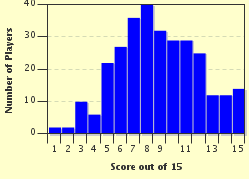Quiz Answer Key and Fun Facts
1. It all started at some point. What was the occupation of Dexter's first victim?
2. Dexter often used his own boat to dispose of the body parts of his victims. What was the name of his fishing boat?
3. Who was responsible for the death of Professor James Gellar, the suspected "Doomsday Killer"?
4. Which of Dexter's victims could be described as a long time friend of the Morgan family?
5. Dexter employed a number of methods in the final dispatch of his victims. Favored among these methods were a knife or a power saw. Which victim did Dexter kill by shooting them in the head?
6. On a few occasions, Dexter would "stage" his crime scene to make his crime appear to be something other than a murder. After breaking this victim's neck (causing death), who was it that was shoved in front of a speeding car, making him appear to have died in the accident?
7. To appear to be normal, Dexter joined and participated in his police station's bowling team. What was written on the logo on the back of the team bowling shirts?
8. Which of Dexter's victims was himself a serial killer and was able to escape detection for more than 30 years?
9. Harry Morgan had the sad task of delivering the eulogy at the funeral of his slain partner. He referred to him as "his hero". What was his name?
10. Which was NOT one of the issues covered by "The Code of Harry"?
11. Which of Dexter's victims listed did NOT meet the standards and guidelines of "The Code of Harry"?
12. During the first six seasons of the series, which character had been married the most number of times?
13. Who did Dexter stab and kill in "self defense" after being attacked?
14. Character Patrick Bateman was first introduced in season two, and had a major role in Dexter's world. Who was Patrick Bateman?
15. During the first six seasons, who was not the subject of a police manhunt?
Source: Author
MaceoMack
This quiz was reviewed by FunTrivia editor
Gamemaster1967 before going online.
Any errors found in FunTrivia content are routinely corrected through our feedback system.

